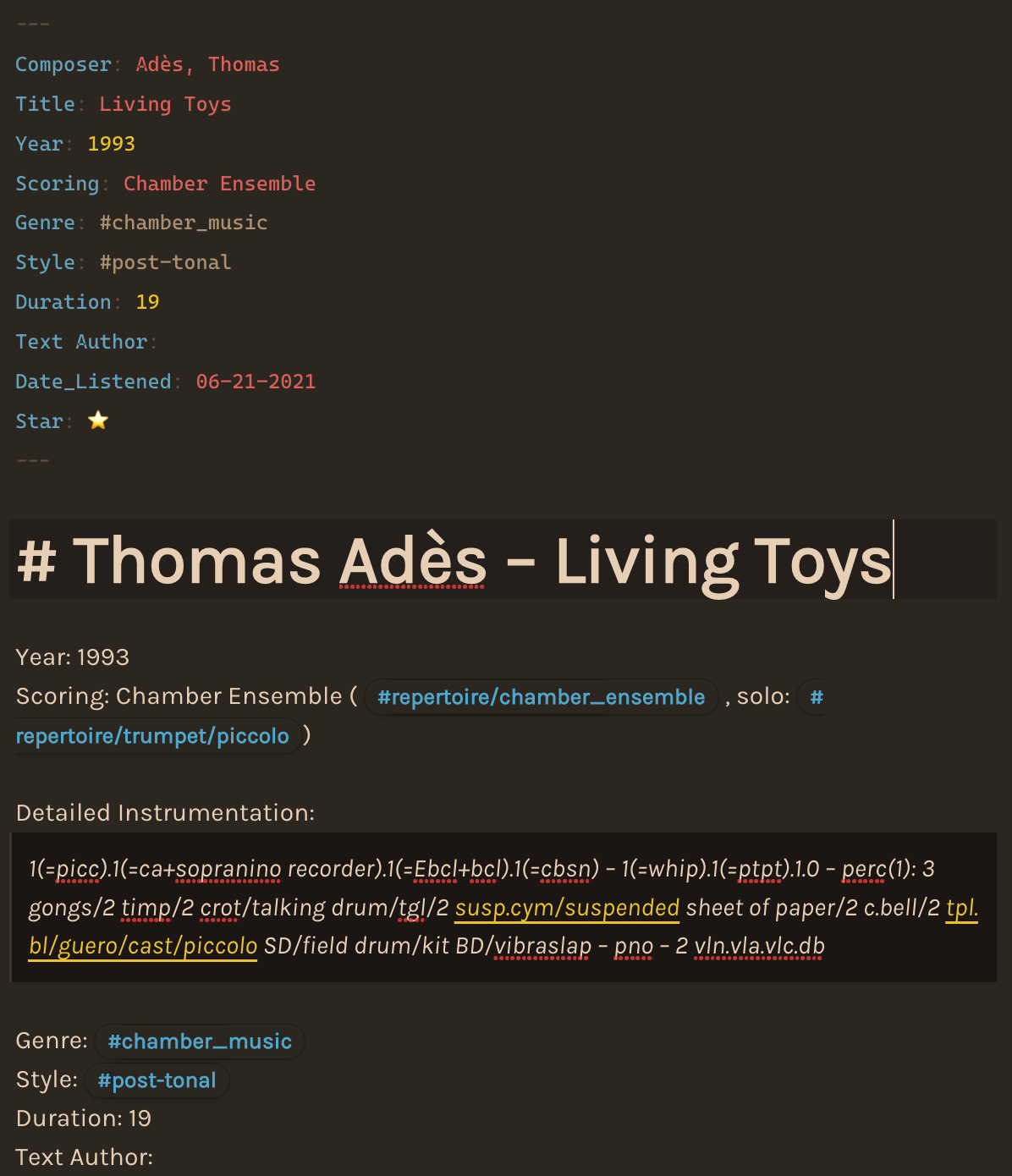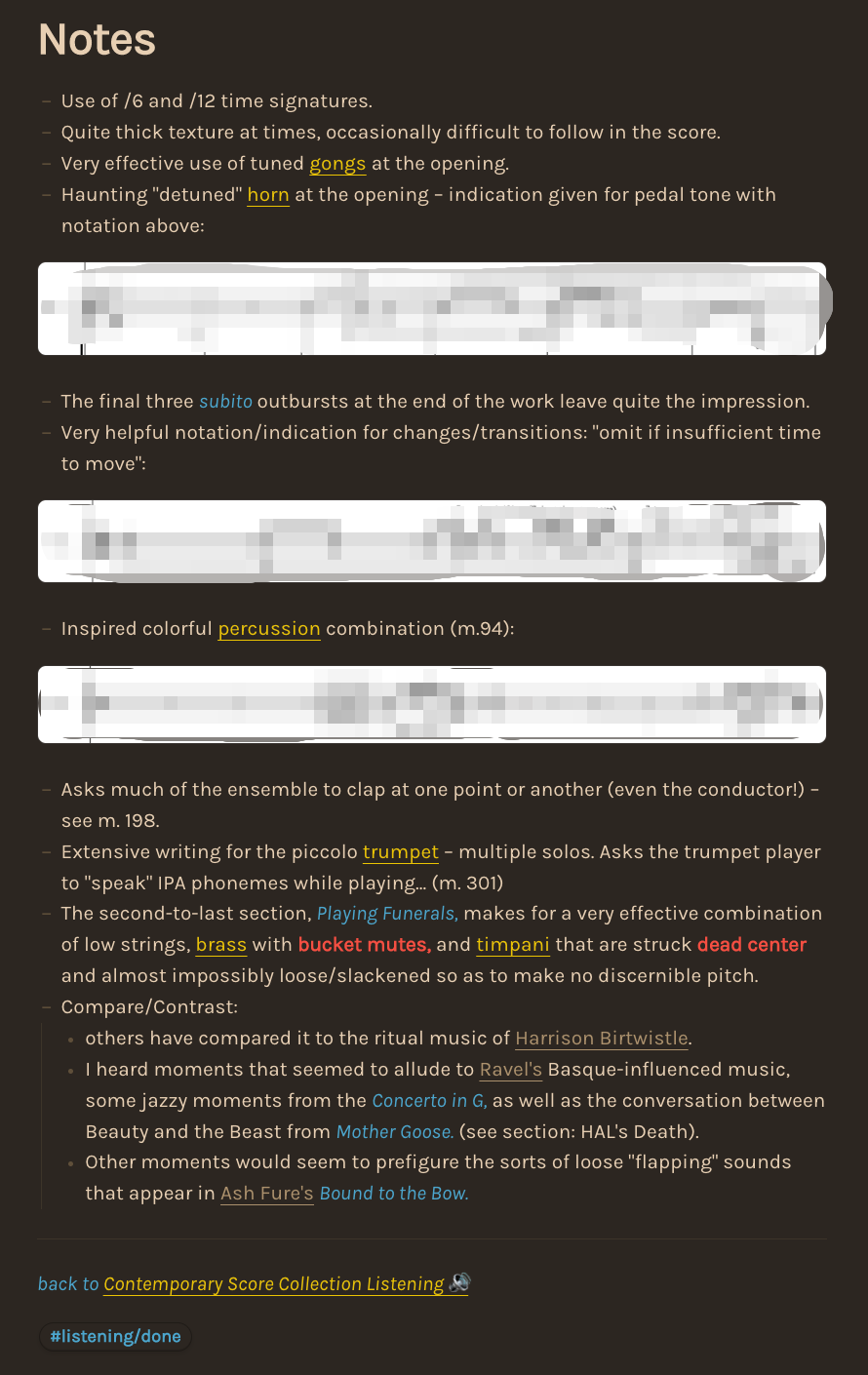Obsidian for Score Study, Part 2
In my previous post, I gave a brief overview of my score study database – the place where I track the scores that I’ve listened to using some blocks of dataview code.
This post will dive into some of how I set up my listening notes to capture information that will be useful down the road. For additional context – I want my listening/score-study notes to serve a few specific purposes:
- General Reference: When I’m in a class, in a discussion with someone, or working on a piece, I want to be able to consult notes with detailed, insightful observations from some of my favorite pieces or from pieces that are important for broader discussion in the New Music and Classical Music communities.
- Indexed Searching: I want to be able to generate results for specific types of searches that will be helpful for furthering discussions with colleagues or furthering my own compositional work. these types of searches could include things like “pieces with idiomatic writing for harp,” “concerto works written after 1995,” “electro-acoustic works that feature flute,” or “pieces that draw on techniques from the Spectralist tradition.” While my digital score-study notes only number 15 entries at the moment, I hope that my ever-growing collection of score study notes will one day make these meta-data-based searches particularly fruitful for identifying works that may be useful at one point or another. (My hope is that my personal knowledge and digital database of observations will continue to naturally grow over many years).
- Cataloguing Examples: Additionally, I want my database to serve as a sort of individualized composition manual – a digital document that collects and records favorite instances of orchestration, harmonic motion, contrapuntal development, electronic techniques, etc. I aim to collect these examples both for the purposes of my own interest in studying music and developing a personal reference, but also as a tool for facilitating future composition instruction through accumulating these observations from years of score study.
Now, I’d like to dive into a sample note and explain some of the techniques that I use in taking score-study notes.
To begin, I capture some meta-data regarding the work so that it will be easier to index and find again through searching in the future. When I started making these score-study notes, I used a rather inelegant solution to add this metadata as “YAML” fields. YAML is a type of computer-readable metadata that begins a markdown note. It might look something like this:
---
title: "My Note"
date: 08-12-2022
author: Peter
---
Everything that is indicated as YAML metadata between the two “‑–” borders actually “disappears” when the note is exported as a different document or viewed in “preview” mode in Obsidian. This can be helpful for fields that are annoying to see all the time.
I later learned that Obsidian provides an alternative way of including metadata in a note that is actually more helpful for me in this situation. I will likely change to specifying score-study note meta-data through some inline fields. The same example from above would then look like this:
title:: "My Note"
date:: 08-12-2022
author:: Peter
This text would appear in the body of the note and in any formats to which the note was later exported (PDF, Word, etc.). This is more helpful because I want these meta-data fields to be both machine-readable and legible for humans to read and understand.
An example of these meta-data fields is given below:

As you can see, my use of YAML metadata has made for redundant meta-data fields that I had to duplicate.
I’ve found it helpful to catalogue a few items including the following:
- Composer name
- Piece title
- Composition year
- Scoring (general description)
- Genre of the piece
- Compositional style
- Duration in minutes
- Author(s) of any text(s) used
- Last listening date
- “Star” status (used to denote favorite works)

In addition I note some of the following items:
- tags for future indexed searches (in this case #repertoire/chamber_ensemble and #repertoire/trumpet/piccolo)
- a detailed instrumentation according to standardized instrumentation specifications,
- a link to the record for the score at my local university library (this may need to be updated if I should move in the future)
- a link to a performance or recording on YouTube
- a Wikipedia article for the piece (if one exists)
- any scholarly articles, reviews, analyses, or essays of music criticism that I find interesting and relevant (in this case this essay from James Donaldson)
If I find it helpful, I then include a segment addressing the movements or formal construction of the work, as well as any crucial details from the performance or program notes that are necessary for understanding the work.
After this has been recorded, I settle in with a copy of the score and listen, marking points to return to on a note pad and making any in-the-moment observations that might be helpful later.

After listening, these observations are compiled at the end of the score-study note. Where I can, I try to make hyperlinks to any other relevant topics, instruments, composers, or works that may prove fruitful (even if I’ve not yet made any notes on these topics).
In addition, I sometimes select a few select instances of notation that are helpful to record. When I have not myself purchased a physical or digital copy of the score, I am careful to capture only small fragmentary examples, mindful of the fair use regulations of U.S. copyright law. (In this case, I’ve recorded just a few measures from a brass and a percussion part). Of course, public domain scores permit a much more thorough use of graphical examples for rich, visual note-taking!
Finally, I’ll observe that taking score study notes in this way has added an unexpected degree of excitement and gratification to the process of score study. I’ve been proud of my progress in a few month’s time and I feel as though every opportunity to explore a new work and record my thoughts is another chance to add to my “garden of ideas” about composition and about the music that I enjoy!
In the next post, we’ll take a look at how to actually set up the dataview dashboard for collecting your listening notes!